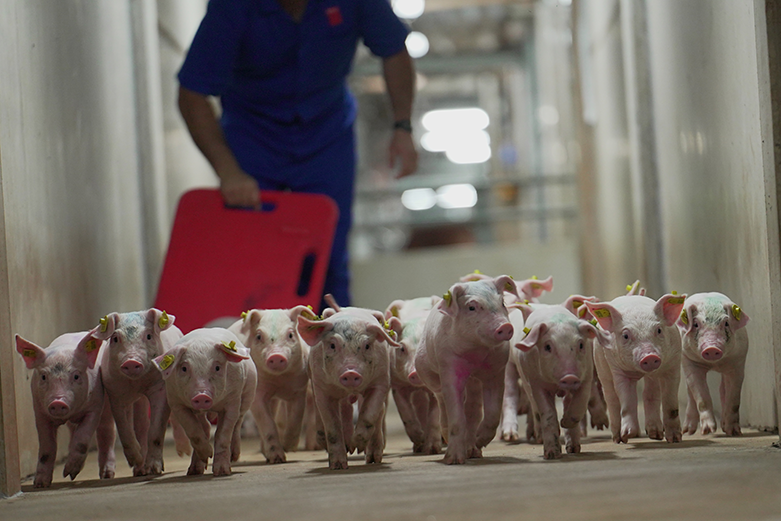Why it matters
In pig production, few moments are as nutritionally and physiologically demanding as weaning. The piglet transitions from a highly digestible, immunologically active diet to a dry feed often unfamiliar to its gut. The sow, in turn, must recover condition, resume her reproductive cycle, and prepare for the next parity. In this dual transformation, feed is not just fuel—it is the foundation for welfare, productivity, and profitability.
How innovative feeding strategies transform weaning outcomes
1. Optimizing Sow Intake: The First Lever of Piglet Success
A high and sustained feed intake during lactation leads to heavier, more robust piglets and prepares the sow for a shorter wean-to-estrus interval. But achieving high intake is complex—it requires careful coordination of body condition, environment, and feeding behavior.
Key innovations and practical steps:
- Environmental control: Sows eat best between 18–22°C. Each °C above this reduces intake by 100–150 g/day.
- Hydration synergy: Feed intake is proportional to water intake. Wet feed (soaking rations) improves palatability and boosts intake by ~10%.
- Intelligent feeding systems: Electronic feeders now enable precise curve monitoring, ensuring each sow’s feed allowance aligns with her individual needs.
- Trained staff: The most advanced tool remains the skilled stockperson—capable of adjusting rations based on residual feed, behavior, and intake trends.
2. Managing the Sow-Litter Dynamic: Balancing Intake and Output
Sow intake must match the energy and nutrient demands of her litter. The article outlines three typical scenarios:
- Ideal case: High intake, large litter, good sow condition post-weaning—predictable return to estrus within 6 days.
- Risk case: High litter size with low sow intake—leads to severe condition loss, delayed estrus (7–12 days), and poor fertility.
- Low-output case: High intake, but small or sick litter—can trigger estrus during lactation, disrupting the weaning-to-breeding rhythm.
Action point: Monitor body condition closely with tools like the Caliper method. For overstressed sows, reduce litter size pre-weaning and consider altrenogest for reproductive synchronization.
3. Weaning the Piglet: From Biological Shock to Nutritional Adaptation
The shift from sow’s milk to dry feed marks a complete transformation in the piglet’s digestive function. Lactase levels drop, microvilli shorten, and gut flora destabilizes. Without a sound nutritional transition, this leads to poor intake, diarrhea, and post-weaning growth lag.
Nutrition tactics that work:
- Familiarity breeds intake: Feed the same prestarte[PM1] r diet before and after weaning to reduce adaptation time.
- Porridge and plates: Offer warm grueling feed for the first 3–4 days to mimic milk’s temperature and consistency. Focus on piglets <28 days or underweight.
- Encourage exploration: Place feed on flat surfaces or plates to mimic nursing behavior and reduce feed neophobia.
4. Formulating Smart: Digestibility, Not Just Density
With the ban on medicinal zinc and reduced antibiotic use, diet formulation must focus on gut health support through ingredient quality and functional nutrition.
What to prioritize:
- High-quality protein: Avoid excess crude protein (17–18% max). Supplement with synthetic amino acids and prioritize digestible sources (milk proteins, fish meal, plasma).
- Functional fiber: Favor insoluble fiber (e.g., hemicellulose) over fermentable soluble fibers in early phases to avoid fermentation overload. A 3–4:1 ratio is optimal.
- Fermentable additives: Acidifiers (organic acids) lower gastric pH, enhancing protein digestion and limiting pathogenic bacteria growth. Ensure low buffer capacity diets to maximize effect.
Example: Adding butyric acid, a short-chain fatty acid produced during fermentation, improves colon structure and nutrient absorption.
5. Plasma and Lactose: Functional Ingredients with Targeted Effects
Plasma remains one of the most powerful tools for improving intake and reducing diarrhea in early diets. Used at 3–6%, it provides immunoglobulins, improves gut integrity, and supports immune function—especially relevant in farms under health pressure.
Similarly, lactose enhances palatability and supports beneficial bacteria. But high levels (>20%) can cause fermentation issues, especially when combined with heat stress or poor hygiene.
Guidelines:
- Use plasma in mash form to preserve immunoglobulins.
- Reduce inclusion progressively after the first phase to prevent intake drop.
- Combine lactose with minimal dextrose (1–2%) to avoid excessive fermentation.
Conclusion: Nutrition Is the Gateway to Performance
At weaning, every gram of feed counts. Strategic feeding—both in composition and delivery—can mean the difference between a thriving piglet and a struggling one. The same applies to the sow: ensuring her nutritional needs are met before and after weaning safeguards her fertility and longevity.
What makes this nutrition plan different is not just its scientific depth, but its holistic approach. PIC and its partners advocate for a management system where feeding is seen as a process, not a product. When combined with good environment, hygiene, and observation, weaning becomes a launchpad.
Success in pig production doesn’t start in the wean-to-finish barn—it starts at the feeder.
References
- Magallón, E., Beitia, S., Magallón, P., Roldán, D., & Prieto, P. (2022). El destete en porcino: manejo óptimo y nuevos retos (Parte 3). SUIS Nº 187.
- PIC Internal Data. Sow body condition scoring and weaning strategies (2023).
- Remaekers, P. (2010). Impact of ambient temperature on sow intake.
- Mollist, F. (2020). Fiber strategies in early piglet nutrition.
- Wellock, I. (2018). Protein quality vs. protein level in piglet diets.
- Pluske, J.R. et al. (2007). Creep feeding and gut development.



